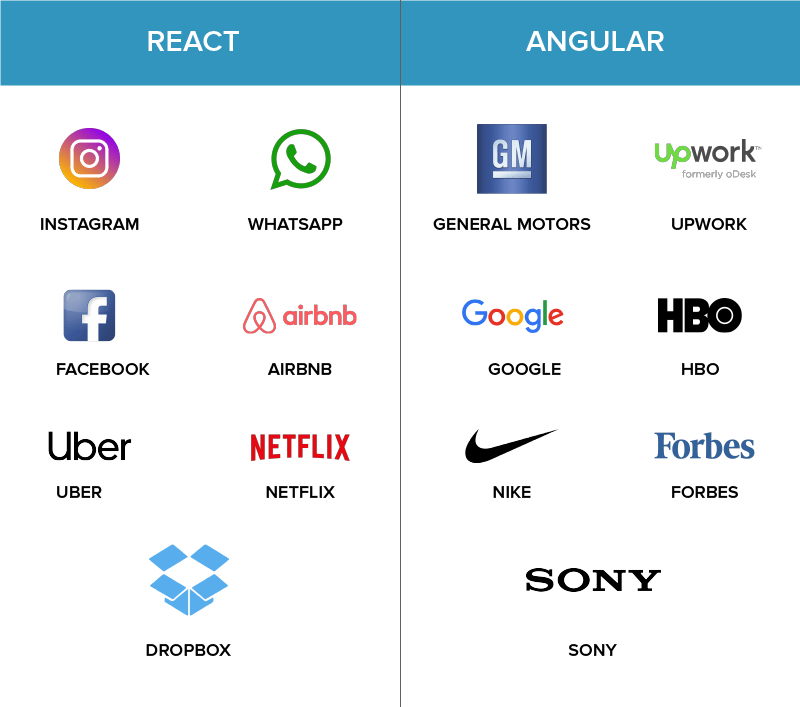I think we can all agree that the world online has undergone massive expansion and seen dramatic proportions of growth over the last two decades. Web development services have diversified exponentially and continue to grow at increasing rates.
With all this rapid development it can be hard to keep your finger on the pulse. Knowing which JavaScript framework is best for your website structure can be confusing, especially if you’ve just dipped your toes in the vast ocean of programming languages and its variants. Not all web development firms work with all kinds of scripts either.
Ecommerce website design services offered by these firms and agencies depend heavily on the type of services your business renders, your stipulated budget and your timelines. In order to help you get a brief idea on what you can choose for your business or website, we’re going to talk about Angular and React, where they can be used and a comparison on some very useful parameters.

But before we proceed let’s have a quick look at what these two terms means.
What is Angular?
Angular is an open source structural framework used for developing web pages and websites alike. Developers use Angular as a tool-kit and work with HTML using it as a template language allowing HTML’s syntaxes to render many application’s components. These components are expressed briefly and clearly herein.
In simple terms Angular is a Ferris wheel of tools developers can use to create websites, webpages, single-page web apps and hybrid apps.
Since its release in 2010 Angular has risen to popularity and amassed a ton of favouritism after having been used to develop projects like Microsoft Office Home, Google Voice, Google Issue Tracker, Messages, Google Transparency Report, Cloud Console, other Google tools, Samsung Forward and many more. Their list is extensive.
If you’re wondering why Google has taken such a liking to Angular, well that’s because Angular is built on TypeScript – a superset of JavaScript that adds optional static typing to the language – which, you guessed it, is developed and maintained by Google.
What is React?
React, on the other hand, is a front-end JavaScript library developed and maintained by Facebook. It was created by Jordan Walke in 2011 and open-sourced in May 2013.
React allows users to create and manipulate interactive front-end User Interfaces with ease. React Java Script framework uses server-side rendering to provide a flexible, performance-oriented solution. React is also easier to use since it makes the code easier to understand and launch.
So now that we know what they are, the question that comes to mind is when to use which.

Your team can choose React’s framework when you need an app with multiple events and when your application development team has expertise in HTML, CSS, and JavaScript. These are the basic pre-requisites for using React and anyone who’s had their foot in the game is well aware.
Although, using React is, so to say, “easy” especially when your product development requires a personalised app solution. Also, if you want to have shareable components in your app project then React is your go-to Script.
Keep in mind, React is a mere JavaScript library and Angular is an entire framework in itself. Angular makes for the better choice for your apps when you need ready to use solutions. This not only makes configuring setups easier but also is favoured by most managers and project leaders due to it being more productive in the long run.
To be able to use Angular your development team has to have enough experience with Java, C# and all previous versions of Angular.
It is also said that Angular has marginally lower app complexities but that can be debated under various circumstances and type of projects that you’re working on. I find myself torn in this aspect due to the fact that each have their own nuts and bolts to tighten and developers have a lot of experience to build that can help boost productivity, irrespective of the platform they’re handling.
Still not sure about your pick? Read on.

There are many ways you can scale and compare the two but we are going to talk about a few select pointers that will hopefully help you make the right choice for yourself by the end of the article.
If you’re new to web development then I suggest you start with React. Angular is not easy for beginners although it is really useful once you know your way around it and have the basics covered. React, on the other hand, is much easier to grasp for a novice. The only time you’ll hit a bump with React is when it is augmented with Redux but it is still suggested over Angular.
React loses to Angular in installation time, taking a lot longer to install, which can be a buzz kill. But if you know how to use React you can be building apps and delivering projects at lighting fast speeds once it’s all set up, but such is not the case with Angular. Due to the very nature of Angular, it can lead to an increased amount of coding thereby resulting in delayed project deliveries.
As a developer you need to test and debug programs all the time. With React you’re going to be burning through your hours since a set of tools are required to perform different types of testing, whereas Angular allows for testing and debugging for a complete project with a single tool.
The best feature about React is that it allows users the freedom to choose the tools, architecture, and libraries, for developing an app but Angular offers a limited amount of flexibility. Angular’s framework being very sensitive restricts you from using larger models whereas React allows users to choose without putting any penalty on performance.
Verdict
Both Angular and React have their own merits and demerits. At the end of the day it’s not the framework that dictates app development, but the user that pick the JS.
The two tools discussed here are used for different applications and as such one can use both at the same time. You and your team need to be well-versed on your needs and obligations and make your pick accordingly based on your requirement and functionality.
If you’re looking for a firm to handle your app and website needs there are several web development companies in New York such as ours that can help you address your needs promptly.
If you have a query leave a comment below and our sales team will be more than happy to answer your questions.
